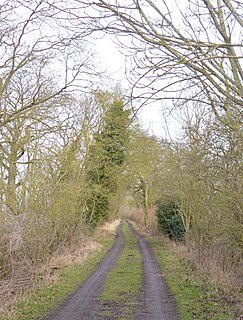| Lower Wood | |
|---|---|
 | |
| Type | Nature reserve |
| Location | Weston Colville, Cambridgeshire |
| OS grid | TL625528 |
| Area | 9 hectares |
| Managed by | Wildlife Trust for Bedfordshire, Cambridgeshire and Northamptonshire |
Lower Wood is a 9 hectare nature reserve east of Weston Colville in Cambridgeshire. It is managed by the Wildlife Trust for Bedfordshire, Cambridgeshire and Northamptonshire. [1]

Weston Colville is a village in South Cambridgeshire, 10 miles southeast of Cambridge and 6 miles south of Newmarket, close to the border with Suffolk.

Cambridgeshire is a county in the East of England, bordering Lincolnshire to the north, Norfolk to the north-east, Suffolk to the east, Essex and Hertfordshire to the south, and Bedfordshire and Northamptonshire to the west. The city of Cambridge is the county town. Modern Cambridgeshire was formed in 1974 as an amalgamation of the counties of Cambridgeshire and Isle of Ely and Huntingdon and Peterborough, the former covering the historic county of Cambridgeshire and the latter covering the historic county of Huntingdonshire and the Soke of Peterborough, historically part of Northamptonshire. It contains most of the region known as Silicon Fen.

The Wildlife Trust for Bedfordshire, Cambridgeshire and Northamptonshire (WTBCN) is a registered charity which manages 126 nature reserves covering 3,945 hectares. It has over 35,000 members, and 95% of people in Bedfordshire, Cambridgeshire and Northamptonshire live within five miles of a reserve. In the year to 31 March 2016 it employed 105 people and had an income of £5.1 million. It aims to conserve wildlife, inspire people to take action for wildlife, offer advice and share knowledge. The WTBCN is one of 36 wildlife trusts covering England, and 47 covering the whole of the United Kingdom.
This ancient woodland has a variety of flora such as oxlips and early-purple orchids in the spring and water avens and germander speedwells in the summer. Muntjac and roe deer use the site and birds include goldcrests, great spotted woodpeckers and tawny owls. [1]

Muntjacs, also known as barking deer and Mastreani deer, are small deer of the genus Muntiacus native to south Asia. Muntjacs are thought to have begun appearing 15–35 million years ago, with remains found in Miocene deposits in France, Germany and Poland. It is listed as Least Concern by the IUCN.

The European roe deer, also known as the western roe deer, chevreuil, or simply roe deer or roe, is a species of deer. The male of the species is sometimes referred to as a roebuck. The roe deer is relatively small, reddish and grey-brown, and well-adapted to cold environments. The species is widespread in Europe, from the Mediterranean to Scandinavia, from Scotland to the Caucasus, and east to northern Iran and Iraq. It is distinct from the somewhat larger Siberian roe deer.

The goldcrest is a very small passerine bird in the kinglet family. Its colourful golden crest feathers gives rise to its English and scientific names, and possibly to it’s being called the "king of the birds" in European folklore. The scientific name, R. regulus, means king or knight. Several subspecies are recognised across the very large distribution range that includes much of Eurasia and the islands of Macaronesia and Iceland. Birds from the north and east of its breeding range migrate to winter further south.
There is access from a footpath along the eastern boundary.
| Wikimedia Commons has media related to Lower Wood . |



















